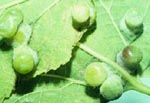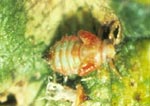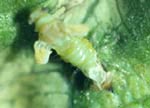Hackberry Psyllids
Pachypsylla spp.
Description

Figure 1. Hackberry
Nipple Galls on Leaf
The hackberry nipple gall is about 1/8 inch in diameter and is nearly 1/4 inch tall. The adult psyllid looks like a miniature cicada. They are usually 1/8 inch in length and have hind legs adapted for jumping or springing from a resting position into flight. Thus, their nickname "jumping plant lice." The eggs are usually yellow to white while the nymphs are a golden yellow. The hackberry blister gall measures 1/8 inch in diameter.
Life History
Psyllids overwinter as adults in the crevices of rough bark, but sometimes inside houses. Mating and egg laying occurs over a number of weeks beginning when new leaves unfold from the buds. Eggs hatch in 7 to 10 days and the nymphs begin to feed on the leaves. At the feeding site, a rapid abnormal growth develops throughout the summer with the adults emerging in September. The hackberry bud gall psyllids occur in early summer. Eggs are laid on the leaves and the nymphs crawl to the newly formed buds where gall formation occurs. The psyllid overwinters as a late instar nymph. There is usually one generation per year.

Figure 2. Hackberry
Psyllid Nymph
Damage
Not considered serious, however, emerging adults can become a nuisance in late summer/early fall due to their large numbers. They may land on cars, buildings or other objects by the hundreds and can be quite annoying. Most host trees do not suffer from these infestations however, severe infestations over a series of years can weaken the tree. In some cases premature leaf drop can occur. If trees are healthy and vigorous they usually are not seriously affected.
Nonchemical Control

Figure 3. Hackberry
Nipple Gall and Emerging
Hackberry Psyllid Adult
There are several parasites that effectively control pysllids. Studies have shown that 47-51 % of the nipple galls were internally parasitized. There is also a species of weevil that is predaceous on these insects.
Chemical Control
Usually not warranted.